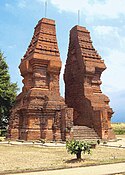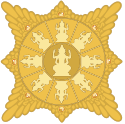Madžapahit
| Madžapahitská říše Kerajaan Majapahit ꦏꦫꦠꦺꦴꦤ꧀ꦩꦗꦥꦲꦶꦠ꧀ Kemaharajaan Majapahit विल्व तिक्त
| |||||||||||
Geografie
| |||||||||||
Madžapahit, Wilwatikta (dnešní Trowulan) | |||||||||||
| Obyvatelstvo | |||||||||||
stará javánština (hlavní), sanskrt (religiózní) | |||||||||||
jávský synkretismus šivaismu a buddhismu (Šiva-Buddha), hinduistické, buddhistické, islámské, animistické | |||||||||||
| Státní útvar | |||||||||||
zlaté a stříbrné mince a měděné mince původně z Číny | |||||||||||
| Státní útvary a území | |||||||||||
| |||||||||||
Říše Madžapahit (javánsky ꦏꦫꦠꦺꦴꦤ꧀ꦩꦗꦥꦲꦶꦠ꧀, Karaton Majapahit; v sanskrtu विल्व तिक्त, Karaton Mojopahit; indonésky Kerajaan Majapahit), též někdy zvaná Wilwatikta (javánsky ꦮꦶꦭ꧀ꦮꦠꦶꦏ꧀ꦠ), bylo ostrovní hinduisticko-buddhistické království a později námořní říše (thalasokracie) zahrnující většinu dnešní Indonésie s centrem na Jávě. Madžapahitské království vzniklo roku 1293 a coby námořní velmoc se rozpadlo v prvních desetiletích 16. století.
Vrcholu moci říše dosáhla za vlády rádži Hajama Wuruka (1350–1389) a jeho prvního ministra Gadži Mady. Podle Nagarakretagamy (také jako Desawarnana, dílo z roku 1365 oslavujicí Hajama Wuruka) bylo na jávském ústředí říše závislých téměř sto států od Sumatry po Novou Guineu,[1] ležících na územích dnes patřících Indonésii, Singapuru, Malajsii, Bruneji, jižnímu Thajsku, Filipínám a Východnímu Timoru (přesný dosah moci Madžapahitu je nicméně stále předmětem diskuzí).
Galerie
- některé památky
- (c) Gunkarta, CC BY-SA 3.0Brána z červených cihel, Trowulan
- Buddhistický chrám Jabung z červených cihel, 14. století
- Brána z červených cihel, Trowulan, 13. století
- Socha královny v podobě bohyně Párvatí
- Cihlový kanál objevený v Trowulanu
- Slunce s hinduistickými božstvy, běžný nález madžapahitských zřícenin a chrámů, pravděpodobný znak říše
- Bronzový kanón přisuzovaný Madžapahitské říši, 14. století
- (c) Gunkarta, CC BY-SA 3.0
Odkazy
Reference
V tomto článku byl použit překlad textu z článku Majapahit na anglické Wikipedii.
- ↑ Majapahit Overseas Empire, Digital Atlas of Indonesian History. www.indonesianhistory.info [online]. [cit. 2011-08-10]. Dostupné v archivu pořízeném dne 2011-07-08.
Literatura
- RICKLEFS, M.C. A History of Modern Indonesia Since c. 1300. 2. vyd. Stanford: Stanford University Press, 1991.
Externí odkazy
 Obrázky, zvuky či videa k tématu Madžapahit na Wikimedia Commons
Obrázky, zvuky či videa k tématu Madžapahit na Wikimedia Commons - (anglicky) A Short History of Majapahit
- (anglicky) Memoirs of Majapahit Kingdom
- (anglicky) The Majapahit era Archivováno 1. 1. 2007 na Wayback Machine.
Média použitá na této stránce
Flag of Brunei before 1906
Autor: Metropolitní muzeum umění , Licence: CC0
Cetbang cannon from Majapahit empire era
Indonesia (Java); Cannon; Metalwork
Circa 14th century
Bronze
Length 37 7/16 in. (95.2 cm)
Gift of Mr. and Mrs. Martin Lerner, in honor of Professor Samuel Eilenberg, 1986.
Accession Number: 1986.503
According to M. Averoes, this cannon's dating was wrong, because it preceded the entry of the breech-loading swivel cannon into the Nusantara archipelago, which he estimated to be occured in the 1460s. From the symbol of Surya Majapahit found on the barrel (to be precise above the fork or swivel fork), it can be estimated that this cannon was made before the fall of the capital city of Majapahit, in 1478. He estimates that this cetbang cannon was made between 1470-1478. A similar cannon can also be found in the Bali museum, with the Surya Majapahit insignia on the front of the muzzle, and the symbol of the 5 cosmic mountains above the fork.
Autor: Gunawan Kartapranata, Licence: CC BY-SA 3.0
Bajang Ratu gate, East Java, Indonesia. The elegant 16.5 meter tall Paduraksa style gate of Bajang Ratu, Trowulan, East Java. The remnant in Trowulan, Majapahit imperial capital. Historian connect this gate with Crenggapura (Cri Ranggapura) or Kapopongan of Antawulan (Trowulan), the shrine mentioned in Nagarakertagama as the holy compound dedicated to King Jayanegara (second monarch of Majapahit) during his death on 1328.
(c) Gunkarta, CC BY-SA 3.0
Wringin Lawang (lit: The Banyan Tree Gate), the 14th century grand split gate, made from en:red brick material with ground size 13 x 11 meter and height 5.5 meter. Located at short distance south of the main road at Jatipasar, en:Trowulan, en:Mojokerto, en:East Java. The type of this gate is called "Candi Bentar" or split gateway, a type of structure which suggested appear during the Majapahit era. Most historian agreed that this structure is the gate of an important compound in Majapahit capital. Speculations concerning the original function of this majestic gateway have led to various suggetions, a popular one being that it was the entrance to the residence of en:Gajah Mada.
Autor: Gunawan Kartapranata, Licence: CC BY-SA 4.0
Expansion and decline of Majapahit Empire, started in Trowulan Majapahit in 13th century, expanded to much of Indonesian archipelago, until receded and fell in early 16th century.
No official flag.
Autor: Gunawan Kartapranata, Licence: CC BY-SA 3.0
The statue of the Hindu goddess Parvati, the consort of Shiva. The statue represent Tribhuwanottunggadewi, queen of Majapahit (1328-1350). The statue originated from Rimbi temple, East Java, circa 14th century CE. The statue now is the collection of National Museum of Indonesia, Jakarta.
Autor: source: BP47Dhorifah, svg: Puck04, Licence: CC BY-SA 3.0
Bendera Pelayaran Majapahit
Autor: Gunawan Kartapranata, Licence: CC BY-SA 3.0
Surya Majapahit. "The Sun of Majapahit" is the emblem commonly found in Majapahit ruins. Displaying the image of eight pointed sun rays. The emblem consist of images of 9 Hindu gods and 8 sun rays also symbolize Hindu gods arranged in eight cardinal points. Total 17 Hindu gods represented in Surya Majapahit are: Shiva, Vishnu, Sambhu, Isvara, Mahesora, Brahma, Rudra, Mahadeva, Sangkara, Kuvera, Isana, Indra, Agni, Yama, Nrtti, Varuna and Vayu.
Autor: Kembangraps, Licence: CC BY-SA 4.0
Part of ancient canal found in Trowulan, located ca. 300 m south west of Trowulan Museum.
Autor: Gunawan Kartapranata, Licence: CC BY-SA 3.0
The statue of Harihara, the half Shiva and half Vishnu god. This statue is the mortuary deified potrayal of King Kertarajasa (Raden Wijaya), the first king of Majapahit (rule 1293-1309). The statue is taken from the temple Candi Simping, Sumberjati, Blitar, East Java, Now it is the exhibit collection of Indonesian National Museum, Jakarta. Raden Wijaya (Nararya Sanggramawijaya) or known as Kertarajasa Jayawardhana was the direct descendant of Rajasa Dynasty.
(c) Gunkarta, CC BY-SA 3.0
Majapahit en:Terracotta Piggy Bank, 14-15 century AD en:Trowulan, East Java. (Collection of en:National Museum of Indonesia, en:Jakarta)
Autor: Gunkarta Gunawan Kartapranata, Licence: CC BY-SA 3.0
'Surya Majapahit' or 'The Sun of Majapahit' is the emblem common found in temples and ruins dated from Majapahit era. Some scholars suggested that this sun disc was the royal emblem of Majapahit, probably functioned as the coat of arms of Majapahit empire. The sun disk is stylized with carved ray of light; surrounded by eight Lokapala gods, the eight Hindu gods that guarded eight cardinal points of the universe. There's other version of Majapahit's Sun, such as sun disc with sun god Surya riding a celestial horse or chariot, to just a simple sun disc with stylized ray of light. (Collection of National Museum of Indonesia, Jakarta)
Autor: ESCapade, Licence: CC BY-SA 3.0
Candi Jabung, Paiton, Probolinggo, Jawa Timur
Autor: Gunawan Kartapranata, Licence: CC BY-SA 3.0
The Nusantara Archipelago during the height of Majapahit Empire in XIV century. The red dot is Trowulan; Majapahit capital city. The dark orange area is core realm of Majapahit on eastern part of Java. The light orange area is vassal states of Majapahit mentioned in Nagarakretagama. The pale yellow is outer realm or independent states from Majapahit. The dark cyan is the sea area under influence or effective control of Majapahit. The light cyan is the extent of Majapahit naval expedition.



























